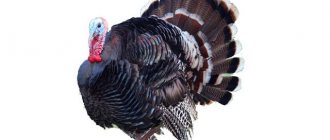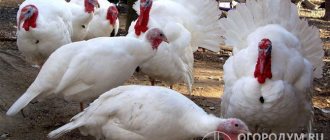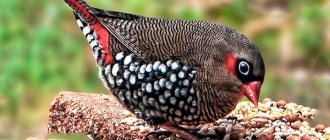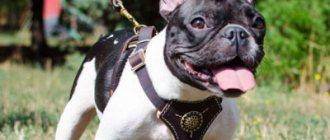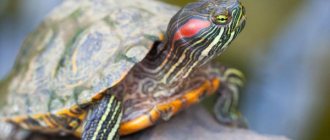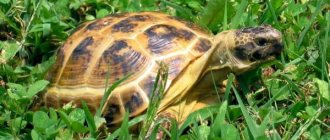Broiler turkeys are a type of poultry, its breeding is practiced by many farmers and agricultural enterprises. They are famous for their unpretentiousness, calm disposition, fertility and excellent taste characteristics of a dietary variety of meat.
In this article we will look at how to raise broiler turkeys at home, what to feed broiler turkeys and how to avoid common diseases.
North America is considered to be the pioneer of most modern breeds of broiler turkeys.
general description
The body of broilers is massive, muscular, with an impressive strong beak with a red appendage. The birds run quickly, and their developed wings allow them to fly over three-meter fences. They reach speeds of up to 50 km/h. Farmers consider broiler turkey breeds to be selective eaters that require specific housing conditions.
There are a number of nuances and recommendations that have a productive impact on the development of turkey poults and maintaining the health of the entire brood. The expended effort pays off in a short time, thanks to the high growth rate of broilers.
Male turkeys
Conditions for keeping broiler turkeys
It is advisable to keep small broiler turkey poults in a specially equipped poultry house. Primary requirements:
- comfortable temperature conditions;
- dry cell;
- unlimited free access to water;
- presence of ventilated air.
The warm season is an excellent time to start raising broiler turkeys at home, providing the opportunity to walk the young animals in the yard. Cages are built wide: turkeys require large spaces.
Grown-up, stronger individuals are released into the poultry yard to eat kilos. Broiler turkeys are domestically bred birds. Some breeds are actively grown by large agricultural enterprises.
External characteristics and distinctive qualities
Broiler turkeys are gigantic in size. The weight of adult males is 20–30 kg. Females grow to be much smaller in size: half the weight of males.
The main purpose of raising broiler turkeys is to obtain high-quality meat. Egg production is an important indicator, however, not the main one. The beginning of oviposition, weight, and number of eggs obtained depend solely on the breed of broiler turkeys.
Now let's talk about what to feed broiler turkeys at home. Adults are recommended to be fed 4 times a day. Broilers always need open access to the feeder, otherwise weight loss will occur. It is preferable to follow a diet. Inconsistent timing of feeding leads to malnutrition. Attacks of hunger are accompanied by irritability and aggressive behavior of birds.
Bronze North Caucasian
It is a product of domestic selection. Place of formation: Stavropol Territory. Local turkeys and bronze broad-breasted breeders participated in the breeding. The bird is mainly bred in the southern part of our country and in the North Caucasus.
Productivity characteristics
Turkeys have an elongated body, deep sternum, and strong long limbs. In size and weight they are inferior to the bronze broad-chested. The average weight of a male is about 15 kg, a female is no more than 8 kg. By the age of 21 days, the turkey chick gains a weight of 4 kg.
Bronze North Caucasian
The bird is adapted for growing on pasture lands and is endowed with a high level of adaptation to various climatic zones. From one female you can get 80 egg products in 365 days. The egg-laying period begins at 9 months. Fertility is 90%.
An interesting feature of the carcasses of young animals is that they have a non-marketable violet-blue color, so turkey poults are practically not used for slaughter.
Types of breeds
The key to successful breeding of healthy, well-fed turkeys is an individual approach to choosing methods for keeping a particular breed. There are three main types of broiler turkeys.
- Light breeds. Do not exceed 15 kg. Males weigh less than females - about 10 kg per carcass. Disease-resistant, strong individuals, females have high egg production rates. These include the Norfolk, Bestville, and White Dutch breeds.
- Medium sized broilers. Highly productive individuals, weighing 16 kg. This includes Moscow and North Caucasian turkeys.
- The largest breeds. The most popular type of broiler. The weight of adult males reaches 30 kg. Females grow half as much - 12 kg. The classification includes broad-chested Canadian white, Canadian bronze, big 6.
Many farmers have the freedom to choose among crossbred breeds of local turkeys. They are more resilient. Hybrid broilers rarely exceed the weight threshold of 10 kg.
The most highly productive and in demand among homestead farms are heavy breeds:
- Canadian broiler broad-breasted. The breed was developed through careful selection.
Almost all types of feed are consumed. The diet should contain various baits and vitamin complexes. Weight gain occurs rapidly. A month and a half later, the chicks reach 5 kg. After another hour and a half, they are ready to be slaughtered for meat. Oviposition of females begins at nine months, the number of eggs laid per year reaches 200 pieces. Canadian broad-breasted broiler turkeys are considered the largest among other representatives of early maturing breeds. The weight of an adult male at three months can reach 30 kg. - White broad-chested. Males reach 25 kg in weight, females - 11 kg. They have an average growth rate. At the age of five months, the weight of the chick is 7 kg. Representatives of the breed are picky eaters. Females have a high degree of egg production - 100 eggs per year, 90% of which will give birth to new chicks.
- Big 6 is a relatively young breed of domestic heavy crosses, which was bred in 2007 in the UK. It has an impressive ratio of total body weight to the amount of pure meat. External features resemble the broad-breasted white, the level of productivity is similar to the Canadian. At 3 months it reaches slaughter age. Weight can reach 30 kg.
How to choose the right breed for private plots
There are not so many breeds of turkeys, unlike breeds of other birds. For breeding on private farms, it is best to choose:
- North Caucasian Bronze - it is ideal for pasture keeping; it begins to lay eggs at the age of 9-10 months for six months. One individual produces 80 large eggs in a light fawn shell.
- Bronze broad-breasted are relatively small birds that begin laying eggs after 10 months. Crosses have similar external characteristics to North Caucasian ones, strong pectoral muscles, and a large body.
- White broad-breasted - birds with tender meat, grow quickly, adapt well to any climatic conditions. Live weight is relatively small, egg production is good.
The main factors to consider when choosing are maintenance costs, productivity, meat quality, and payback. This article will tell you about the Bronze Broad-breasted turkey breed.
Broiler turkey
This breed was developed as a result of hybrid crossing. This type of poultry has a heavy, strong body, a strong and powerful beak with a red appendage. The wings are fully developed, with their help the turkey is able to fly over a fence three meters high, and thanks to its strong legs it can run at a speed of 50 km/h.
The advantages of raising these birds include the following:
- Ecological purity of homemade meat.
- The nutritional value of meat is that it contains an abundance of valuable microelements and vitamins and, at the same time, an extremely small amount of fat.
- High nutritional value and good taste of turkey eggs.
- When breeding for sale, there is a quick payback: a higher price for meat due to the fact that it is considered rare.
- Waste-free breeding and sales of products. In fact, everything can be sold: chicks of all ages, feathers, down, meat, eggs.
But the disadvantages of growing are:
- The need for special conditions for keeping young poultry.
- High probability of mortality.
- More significant costs when equipping a yard - large birds require more space.
- Separate keeping of young birds away from other poultry due to the great timidity of young turkey poults and possible diseases.
- Larger quantities of feed and the need to control its quality.
- Due to the tendency of turkeys to become obese, an increased amount of greens is required in their diet.
- Delayed sexual development - usually by nine months of age.
Did you know? Turkeys are the largest poultry from the gallinaceae order. Only ostriches are bigger than them.
What to feed turkey poults
Industrial crosses are fed only with specialized feeds, in which all the nutrients and vitamins needed by the bird are presented in the required proportions. For fattening young animals, there are three types of complete feed: Start, Growth and Finish. They are given only in dry form, without enriching the diet with anything other than the addition of fresh herbs.
- Start. Designed for young animals aged from 1 to 15 days. The mixture is based on corn and wheat with the addition of cake, herbal flour, and a complex of vitamins and minerals. This food contains 21–22% protein. Available in the form of grits or small granules, which are easily eaten by turkey poults.
- Height. This compound feed is fed from 2 to 8 weeks. It contains less protein, but is enriched with vitamins necessary for active growth.
- Finish. Compound feed is fed from the 9th week until slaughter.
Experienced turkey breeders prefer Purina products.
At the stage of finishing fattening, many poultry farmers, in order to save money, replace the finished mixture with self-prepared compounds. Recipe for 1 kg of finishing feed for turkeys:
- 700 g of crushed corn, barley and wheat (grain taken in equal parts);
- 140 g sunflower cake;
- 50 g herbal flour of legumes;
- 30 g feed yeast;
- 40 g fish meal;
- 30 g limestone or crushed eggshells;
- 10 g salt.
Premix for broiler birds is added to the finished mixture according to the instructions.
Heavyweight breeds
“Heavyweights” include turkeys that quickly gain slaughter weight:
- in 16 weeks - from 18 kg;
- for 28 weeks - maximum weight 26 kg.
Let's look at some of them.
Broad-chested white
This breed was developed in the last century in North America. The body is covered with bright white feathers; a “bow” of black feathers is clearly visible on the chest. The body is large, oval in shape. Weight can reach 25 kg. Unpretentious, well suited for growing in cages.
They lay eggs from nine months. Egg laying lasts several months; during laying, about a hundred eggs are laid, of which 90% are fertilized. They are picky about food, they only need high-quality feeding, with mandatory valuable additives.
Moscow bronze
Bred in the middle of the last century by crossing local bronze turkeys with bronze broad-breasted ones. Clutch - about 90 eggs, of which over 90% are fertilized. Males gain weight up to 12 kg, females - up to 7 kg.
Hybrid converter
Turkeys of this breed were bred in Canada. Their advantages: attractive presentation, excellent quality and high level of meat maturity. They are distinguished by a wide chest and white plumage. Agile and muscular. The head is small in size, the beak is powerful with a bright red earring.
Running speed is 45 km/h, take-off height is 2 meters. By the fifth month, males weigh 19-22 kg, females - from 9 to 12 kg. Clutch - 50 eggs in three months, the female incubates them for about four weeks.
BIG-6
The breed was bred in England in 2007. Characterized by high productivity and high meat maturity. Reaches slaughter age at 3 months. The weight of a male can be up to 30 kg. Typically, the male weighs from 15 to 17 kg, the female - 6-7 kg. The fertilization rate of eggs is about 80%.
We advise you to learn more about the features of keeping and breeding broiler turkeys of the Broad-breasted White and Big 6 breeds.
BYuT-8
They are distinguished by a convex body, strong paws, a red beak with a “beard” and an arched neck. The feathers are completely snow-white. By 18 weeks of age, males have a live weight of 15 kg. During the day, live weight increases by 110 g. An adult male has a live weight from 28 to 30 kg, a female - 14 kg.
Features of feeding broilers and meat crosses
The main goal of breeding is to obtain meat products with high taste characteristics. Based on this, feeding meat crosses is not as simple a task as it seems. You need to know that each type will need its own diet. It will be easier to navigate using the example of general principles.
Broiler turkey poults should be fed twice a day. On the first day, newly born babies should be given a mixture of boiled, finely chopped eggs with millet. From the second day you can give grated carrots, then finely chopped green leaves of dandelions or nettles.
It is important to keep the quality of feed under control; wet mash is prepared no earlier than half an hour before feeding; you will need to pick up the feeders after 30 minutes. Young broilers need four feedings a day
The diet must be balanced and contain all the necessary vitamin and mineral supplements. It is also necessary not to forget about the presence of containers with gravel or shell rock
Young broilers need four feedings a day. The diet must be balanced and contain all the necessary vitamin and mineral supplements. It is also necessary not to forget about the presence of containers with gravel or shell rock.
Adult birds should receive:
- corn;
- vegetables;
- grass;
- meal;
- cakes;
- dairy products.
The role of vitamin and mineral supplements is performed by: eggshells, feed chalk and yeast, as well as fish oil.
Particular attention should be paid to the light type of broilers. These poultry include the following breeds
These poultry include the following breeds.
Black Tikhoretskaya
The breeding dates back to the last century, and it took place in the Krasnodar region. A distinctive feature can be called a black suit. Farmers should be aware that such birds should not be kept in cages due to their high mobility.
Black Tikhoretsk
Productive characteristics
You can find representatives with the following indicators: males weigh up to 10 kg, and turkeys 5 kg. The egg production rate is up to 70 eggs from one female in 365 days. The percentage of slaughter yield is 93. It is worth noting that eggs taste little different from chicken eggs.
Bronze turkeys
They are an ideal broiler breed suitable for growing at home. Compared to their broad-chested counterparts, the birds are more miniature. The characteristic color is black with a bronze tint. It is best to keep such birds in an aviary, with a designated place for walking.
Productive qualities
Adult turkeys weigh 8 kg, and turkeys 6 kg; the egg production rate of individuals reaches hundreds of eggs in 365 days from one bird. The slaughter yield as a percentage is 90.
The most common diseases that can be encountered in keeping broiler turkeys
If improper care, feeding or failure to follow basic hygiene rules, the bird can get sick. In the following table you can familiarize yourself with the most common diseases, symptoms and treatment.
| Name of the disease | Symptoms | How to treat |
| Newcastle | The early stage is characterized by a disorder of the digestive system with gray or yellow diarrhea, then limbs become paralyzed | Timely vaccination |
| Sinusitis | Swellings appear under the organs of vision, coughing, wheezing, and shortness of breath. | Use of antibiotics |
| Pullorosis | Lack of appetite, yellow diarrhea, drooping wings | Use of antibiotics |
| Histomoniasis | The diarrhea may be green or orange with a foul odor | Treatment with Furazolidone, Osarsol |
We invite you to join our group on VKontakte or Odnoklassniki, where new articles are published, as well as news for gardeners and livestock farmers.
Necessary conditions for keeping broiler turkeys
By the end of the first month after birth, the young animals are transferred to the turkey poultry. There are two types of keeping turkeys: caged and free-range. We will consider the option of keeping indoors.
Important! Chicks and adult turkeys must have access to clean drinking water at all times.
Premises requirements
The room (cage) for grown-up turkey poults should be selected or equipped according to the calculation: no more than two broilers per square meter. The temperature should not fall below 20°C. Daylight hours should be 12-13 hours or more. If necessary, daylight hours can be extended using additional illumination lamps.
How should a turkey poultry be equipped?
Its arrangement must meet the following basic requirements:
- Reliability of the structure, preventing any animals from entering inside, especially snakes and all kinds of rodents.
- Zoning the turkey poultry will prevent disorientation among the birds, and will also prevent collisions between males and thereby save the livestock.
The main areas should be:
- Feeding plot. Equipped with containers for different types of food - bulk, dry, wet. The size of the container is at most a quarter of a meter per individual. Drinkers can be placed in different places or in a line, with a constant supply of clean water. The floor is covered with a bedding that can absorb moisture, which should be changed or placed on top of a fresh one, this is done to avoid the spread of infections.
- Perches. They are made from thick crossbars with rounded ends. They are usually equipped starting from 70-80 cm from the floor surface in the form of gradually rising ledges located in a semicircle or circle. Calculation of the number of perches - 45 turkeys per one. They are located in the most shady place without any lighting. A deep bedding or tray is placed below and is periodically cleaned.
- Walking. It is located between the sleeping area and the feeding area. It would not be amiss to lay out heaps of limestone and chalk around the perimeter, and arrange ash baths. This location will be where the most turkey activity will occur during inclement weather.
- Nests. Installed in a quiet and no-passage corner. One place is equipped for four to five females. They are made in the shape of a house with a pitched roof, always with a hole slightly higher than the level of the nest and the size of a turkey. Smooth straw is used as bottom bedding.
- Sections for broilers of different ages. Young animals or the most aggressive males are placed there for the first time.
Important! Sawdust and shavings are strictly prohibited for use as bedding when keeping broiler turkeys - they may mistake these materials for food.
Walking area
Walking outdoors is very beneficial for broiler turkeys. However, due to the characteristics of these birds, the place for them to be outdoors must be appropriately equipped:
- The site should be spacious (the larger the better).
- High (at least three meters) fencing.
- Canopy. As protection from the sun and precipitation, with a low fence it is an obstacle when the bird tries to escape.
- It is advisable that the land be sown with forage grasses (one- or perennial) - this will enrich the turkeys’ diet with proteins and fresh herbs.
- In the warm season, equipment is required for feeders, and, of course, drinkers.
Video: turkey walking area
Maintenance and care
White broadbreasts were once bred for southern climates.
Therefore, they are very susceptible to conditions of detention. It is necessary to carefully prepare the poultry house and constantly monitor its cleanliness during the life of the bird. If you follow all the conditions, you will soon get an excellent result. Turkeys on the range
Place for keeping
To keep turkeys, you can adapt an old chicken coop or build a new poultry house. If you choose the first option, remember that the chicken coop should be thoroughly disinfected and cleaned. This will help avoid illness. It is also worth considering the size of the room: turkeys are much larger than chickens and they require more space. There should be at least 1 sq.m per individual. premises. In any case, you should not keep too many birds in one place. This can lead to conflicts. It is better to raise the floor of the poultry house by 25 cm and cover it with straw or sawdust.
Turkeys in the poultry house
Like other poultry, turkeys of this breed sleep sitting on perches. Remember that turkeys are larger than chickens and their roosts need to be larger. The minimum width is 40 cm. If you place perches on top of each other, make sure that the distance between the perches is more than 60 cm. In this case, the distance from the ground should be about 80 cm.
Temperature, humidity and lighting in the poultry house
White broad-breasted birds are heat-loving birds. The house should always be warm and fairly dry. These birds absolutely cannot tolerate dampness. In summer, the temperature must be kept within 25 degrees. In winter, do not allow the poultry house to cool by more than -5 degrees
It is important to provide a hood or ventilation holes. But do not allow drafts, they are destructive for turkeys
Make sure there are no drafts in the poultry house
You can illuminate the poultry house using windows that face southwest or south. But make sure that they are not blown out. In the cold season, lamps will provide a sufficient amount of light. In the warm season, daylight should last 12 hours, and in winter it is better not to increase it by more than 14 hours.
Pasture
Since this breed is prone to obesity, it is worth taking care of pasture in the warm season
It is important to let turkeys go outside for exercise. The place should be spacious, preferably with plenty of fresh grass
Young animals on the range
And in winter, walks down to minus 5 degrees can be done in the snow. But if the temperature drops even lower, then you need to scatter straw on the snow. This will protect the birds from hypothermia. Turkeys are quite freedom-loving birds, so take care of fencing the perimeter of the pasture. It is better to choose a dense fence, it will protect them from the wind, which they are afraid of.
Feeding
Correct and timely feeding is no less important for the normal development of the bird than the living conditions. Here are the basic nutritional recommendations for turkeys of this breed:
It is important to include both dry and sprouted grains in your daily diet. In addition, birds should be given wet and dry stirrers. In the warm season, it is necessary to give birds a lot of greenery. In the cold season, carrots, beets, and steamed hay can replenish your supply of greens. It is necessary to feed three times a day, and during the breeding season the number of feedings is increased to 5 times. It is better to give wet food in the morning and dry food in the evening. The more succulent food there is in a turkey's diet, the juicier the meat it will have.
Correct location of the feeder
An important point is not only the food itself, but also the methods of serving it. If the feeders are chosen correctly, they will make the feeding process more organized and economical. It is better to place the feeder at the height of the turkeys’ back. Separate feeders should be provided for small and adult individuals. In addition, wet and dry food are poured into different containers. For dry food, it is convenient to use automatic feeders - the food is poured into them as soon as it is finished. Since turkeys are quite large birds, it is worth taking care that the feeders are well secured.
Drinking bowl in the turkey poultry
It is worth paying close attention to the drinking bowl, as turkeys of this breed drink a lot. They always need access to clean water
If you use regular waterers, it is important to set them at a level so that water does not get on the turkeys. A nipple drinker is considered the best option, since liquid does not stagnate in it and each bird receives as much water as it needs.
But such drinkers are not suitable for young animals; for small turkey poults it is better to use a vacuum drinker.
Diseases of broiler turkeys
With proper care, birds are not prone to serious illnesses, but they can still catch viral infections. Negligence in temperature conditions or abuse of ventilation can cause the phenomenon of birds sneezing. This symptom usually indicates a cold, and showing the animals to the veterinarian is a prerequisite for preserving the lives of the entire turkey population.
Common diseases of broiler turkeys are:
- Mycoplasmosis is respiratory. A cold with a pronounced tendency to sneeze affects birds in the cold season with fairly high humidity in the room. Treated with antibiotics under strict veterinary supervision.
- Tuberculosis. A dangerous disease that is practically untreatable, but it can be prevented with effective preventive measures. Prevention of the disease consists in the absolute cleanliness of the premises, birds and eggs.
- Histomonosis. It most often affects chicks due to insufficient compliance with hygienic rules for caring for turkey poults. Removal of parasites is carried out by a professional veterinarian using special preparations.
- Helminths. The most insidious contagious disease, because the initial stage of infection is not visible externally. Typically, broiler turkey breeders turn to doctors when the birds are very thin and weak in the legs.
- Smallpox. It appears as rashes on non-feathered parts of the body and is transmitted from insects. This disease cannot be cured, so sick birds must be isolated and destroyed.
Broiler turkeys are susceptible to many diseases, not all of which can be cured. But with proper care and compliance with all breeding rules, birds grow healthy and well-fed.
Breeding secrets
There are some secrets to raising broiler turkeys that can simplify bird care to a certain extent, as well as achieve better results. For example, the most active, healthy and strong representatives of the breed should be selected for breeding. They should have a dry umbilical cord and smooth fluff.
Adults, just like young animals, must have a healthy appearance. Their droppings should not be liquid. You need to know that liquid droppings are the first sign that the bird is sick.
Correct living conditions are considered the key to successful breeding of this poultry. When caring for turkeys, important points are:
- cleanliness and dryness in the poultry house;
- temperature regime correctly set depending on the age of the bird. It is best to keep birds of approximately the same age in the same turkey poultry. This makes it easier to set the optimal temperature for a certain age;
- good lighting;
- balanced nutrition, which should be selected based on the age of the turkeys;
- clean water, which is always available in the drinking bowl.
The biggest enemy of this type of poultry is drafts. However, the room should be ventilated periodically. This will avoid many problems associated with parasites and infections.
It is important that there is enough free space in the room, as birds sometimes start running in circles.
Classification of birds by breed mass
As mentioned above, all known varieties of broiler turkeys are divided into groups depending on the weight of adult individuals.
- The first group includes light species of birds. Their distinctive feature is that the weight of females significantly exceeds the weight of males. If we give specific values, then on average females reach fifteen kilograms, and males ten kilograms. The above feature makes it easier to breed them naturally due to the fact that males cannot cause significant damage to females during mating. These breeds of the first group are closest to wild turkeys. They are also the most resilient, have the highest immunity, and have good egg production. Despite the listed advantages, the varieties of the first group cannot be called popular due to the obvious disadvantage - their small maximum weight. Representatives of the first group include the Bestville and White Dutch breeds.
- The second group includes species of birds with average weight. Females and males of this group of broiler turkey breeds grow to approximately the same sizes, from fifteen to twenty kilograms. They also have a high reproductive rate. A popular representative is the North Caucasian breed.
- As you might guess, the third group includes large breeds. This group is very popular for breeding on an industrial scale. This is due to the fact that males of the third group are significantly larger than females in size and reach thirty-five kilograms. Females, on the contrary, most often do not exceed fifteen. The size of the males makes breeding the third group very liquid, but the difference in weight between female and male individuals greatly complicates the process of natural reproduction. Therefore, they are not very popular for breeding at home. The third group includes such breeds as Big-6, Canadian white, bronze turkeys.
Most often, farmers breed mixed breeds at home. However, when crossing individuals of different breeds, there is a high probability that the brood will not have a large mass.
Some aspects of cultivation
Recently, separate rearing of turkeys and turkeys intended for slaughter has been promoted. In this case, feed consumption is more rational, and weight gain increases by a quarter to a third. Separation is carried out at 8 weeks of age, before planting in the turkey poultry.
Females are fattened no longer than 20 weeks, because after this period the growth rate slows down. Males grow up to 26 weeks, i.e. one and a half months longer. Females destined for breeding are selected during the rearing process and kept until 9 months of age, and then mated with a male.
When selecting birds for breeding, it is necessary to use birds with characteristic characteristics of the breed and exclude inbreeding.
Turkeys are significantly smaller than turkeys
Important! The offspring of a purebred bird repeats the parental characteristics and successfully reproduces the bird flock. The offspring of crosses are rarely successful - complex selection when creating a cross has a side effect - the parental characteristics are split. Therefore, cross-breed eggs are often used as a food product, and not for restoring the population of the poultry yard.
Thus, raising turkeys of one or more breeds can become the basis for the financial well-being of both an individual family and a farm. You just need to competently approach the development of the concept and take into account the smallest aspects of the matter.
Reproduction
Many farmers are also interested in ways to increase the number of poultry such as broiler turkeys on their farm. Breeding these animals is a relatively difficult matter. Like chickens, the offspring of turkey crosses, unfortunately, do not adopt the high productive qualities of their parents. It is possible to obtain good young animals from eggs laid by a bird only if it is not a hybrid, but belongs to some good meat breed.
In principle, it is quite possible to obtain cross-broiler chicks in an incubator on your own. But in this case, you will have to buy eggs from a poultry farm. They are, of course, cheaper than turkeys. But it is quite difficult to breed chicks from them without loss without proper experience.
Character and brooding instinct
Both females and males of the described breed do not have a bad character, therefore they behave like most of their relatives. At the same time, the brooding instinct of turkeys is much stronger than that of some other breeds, so in order not to bring the bird to exhaustion (sitting on the nest, it forgets about food), it is worth placing a feeder and water bowl next to the nest.
In the case where there are no plans to hatch chicks yet, it is better to place all nests in a well-lit area of the poultry house so that the turkey does not feel so comfortable incubating the eggs. Birds at the age of two are considered the best hens, but the activity of males is most noticeable at the age of 3–4 years.
Important! Maximum hatchability can be achieved from eggs that have lain for no longer than four days before laying.
Broiler turkeys: raising young animals
After the chicks hatch, they should be placed in boxes or a special brooder and provided with 24-hour lighting. This will reduce possible lunge to a minimum. A day after hatching, the lamp in the box or brooder can be turned off for half an hour. Next, the lighting time is reduced by another 30 minutes every day.
The bedding of turkey poults should be changed as it gets dirty. Food and drink should be present at all times in the chicks' box or brooder. At first, young animals should be fed with a special “Start” mixture. You can also offer the chicks chopped eggs and cottage cheese. For the first three days, turkey poults are given green tea rather than raw water.
Feeding a day old chick
Boiled water is suitable for the first feeding. A little sugar and chopped hard-boiled eggs are added there. You can also add crushed grain to the mixture.
Boiled egg is the best food for newborns
For variety, you should take onion feathers as a second feeding. They are considered very beneficial for all birds.
Chopped green onions are the most important treat for turkey poults.
Day-old turkey poults will eat boiled porridge with great appetite. Low-fat fine-grained cottage cheese and grated carrots are added there.
Don't forget about the vitamin complex. Birds should receive it from the first days of life. Useful elements are contained in young greens:
- nettle;
- alfalfa;
- clover;
- rapeseed.
They can be given in detailed form from the 2nd day of life.
Plants contain many vitamins
In the autumn, instead of these plants, it is advisable to fill the feeders with carrot or beet tops, as well as cabbage leaves. They are advised to mix with boiled eggs or porridge.
On the second day after birth, wheat dirt, millet and greens are included in the diet. To soften the resulting mixture, broth, yogurt or whey is added to it.
It is best if the main of the listed components from days 2 to 10 of the life of turkey poults are in the following ratio:
| Product name | Percentage (%) |
| Wheat | 67 |
| Corn | 68 |
| Bran | 11 |
| Eggs | 11 |
| Cottage cheese | 11 |
| Shell, chalk | 2 |
To prevent young animals from injuring their beaks, at first it is better for them to sprinkle food on a small plywood sheet
From the first day, some poultry farm owners use ready-made feed of the PK-5 brand, which contains a large amount of protein. It is alternated with a curd-onion mixture every 2 days
However, in this case, it is important that the finished food is very fresh - no more than 1 month from the date of packaging
Pk-5
Some experts recommend trying the following diet: on the first day, hatched chicks are fed only water, on the second day they are fed boiled chopped eggs, and on the third day they are switched to broiler feed. This method of feeding has its place, and it can be tried in practice.
Food and water should be in convenient drinking bowls
All poultry farmers agree that young birds need plenty of water. The water should not be too cold or hot. It is best if the liquid is warmed to room temperature. To prevent gastrointestinal infections, you can add a couple of drops of potassium permanganate to the water. Drinks should be poured into special covered drinking bowls so that turkey poults cannot get their paws into them. You can pour yogurt into separate containers - birds love this product. Plus, it's useful. Some poultry farmers believe that for this reason, yogurt can be given without restrictions. However, most experts still agree that in large quantities, dairy products can disrupt the microflora in the stomach, which in turn is dangerous for intestinal disorders.
Young animals need plenty of fluids
In the first days, it will be difficult for the chicks to find drinking bowls and feeders. Therefore, their home needs to be provided with good warm lighting.
To attract attention to food, you can lightly tap your fingers on the feeder.
The home must be provided with good warm lighting
Prices for infrared lamps
Infrared lamp
The listed types of diets are relevant during the first week of life. Then it must be changed so that the gastrointestinal tract of birds functions well.
First food for chicks
From 5-6 days of life, experienced farmers advise making a wet mash, which consists of homemade dairy products
It is important that such mixtures are crumbly, because the sticky consistency causes digestive disorders in young animals. It is recommended to add a few drops of fish oil to such mashes to increase overall immunity.
Turkey mix
You can use a simple recipe as the first mixture. Mix hard-boiled eggs (6 g per head at a time) with cottage cheese, corn, wheat bran, carrots and green onions.
There is a lighter version of the recipe - grated egg should be mixed with wheat or corn flour in a small amount. This food can be given from 2 to 7 days. Next, it is advisable to exclude the egg from the diet.
Cottage cheese is necessary in the diet of chicks
Healthy food for the first days of life can also be made from low-fat cottage cheese, grated carrots and onions. Everything is ground in equal quantities.
Pros and cons of growing
Positive aspects of breeding turkeys:
- A large amount of meat at relatively low feed costs. For every kilogram of live weight, up to 2 kg of feed is consumed.
- High quality meat: dietary, with a low amount of fat and a large amount of easily digestible protein.
- Large eggs.
- Rapid weight gain - broiler turkeys are usually bred for the summer. By autumn they gain slaughter weight.
- Very often, turkeys will easily sit on eggs and hatch them, which will make breeding easier.
But there are also some disadvantages that you need to be prepared for when raising broiler turkey poults:
- Sensitivity of chicks to dampness and cold.
- The need for a high fence.
- Some individuals may be aggressive.
- Difficulties in slaughtering and eviscerating the carcass due to its large size.
- Heavy crosses, 15-25 kg each, have difficulty reproducing on their own. Due to their large size, these turkeys require artificial insemination.
Important! There are “light” versions of broilers that are quite capable of reproducing naturally.
Prevention of parasite infestation
It is better to prevent the appearance of parasites in advance than to treat birds later:
- Conduct regular bird inspections. It is necessary to select several individuals from different parts of the poultry house and carefully examine them in a bright room. There should be enough light so that even the smallest parasites can be seen. The head, leg and anus of the broiler are selected for inspection;
- In addition to the birds, you should also inspect the turkey poultry itself. Parasites can live on walls, floors and straw. To determine their presence, white materials are placed in these places, on which any parasites can be easily seen;
- and also in each turkey poultry there should be boxes with ash and sand. Turkeys will be able to clean themselves with this mixture.

